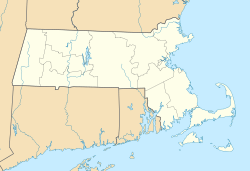Christ Church (Cambridge, Massachusetts) facts for kids
|
Christ Church
|
|
|
U.S. Historic district
Contributing property |
|
 |
|
| Location | Garden Street, Cambridge, Massachusetts |
|---|---|
| Area | 0.5-acre (2,000 m2) |
| Built | 1761 |
| Architect | Harrison, Peter |
| Architectural style | Georgian |
| Part of | Cambridge Common Historic District (ID73000281) |
| NRHP reference No. | 66000140 |
Quick facts for kids Significant dates |
|
| Added to NRHP | October 15, 1966 |
| Designated NHL | October 9, 1960 |
| Designated CP | April 13, 1973 |
Christ Church is a historic church located at Zero Garden Street in Cambridge, Massachusetts, USA. It belongs to the Episcopal faith. This church was built a long time ago, between 1760 and 1761. It's special because it was designed by Peter Harrison. He was one of the first trained architects in the American colonies. Because of its importance, Christ Church is recognized as a National Historic Landmark.
Contents
History of Christ Church
A Church for Cambridge
The idea for Christ Church started in 1759. People who lived in Cambridge wanted a church closer to their homes. They were members of King's Chapel in Boston. They also wanted to offer Church of England services to students at Harvard College. The first leader of the church was East Apthorp. Many of the first members lived on a street then called Tory Row. Today, this street is known as Brattle Street.
Design and Building
The famous architect Peter Harrison designed Christ Church. He also designed King's Chapel in Boston. Christ Church is one of the few buildings still standing that he designed. It was built in the Georgian style. The church's wooden frame sits on a strong foundation. This foundation was made from granite stones. These stones were used as ballast in ships coming to Boston Harbor. The church was first painted to look like a traditional stone church in England.
During the American Revolution
During the American Revolution, Christ Church faced some challenges. People who supported the American cause sometimes attacked it. This was because the church was seen as supporting the British side. However, something very important happened there. George and Martha Washington attended a prayer service at the church. They were staying nearby at what is now Longfellow House–Washington's Headquarters National Historic Site. The church closed during the Revolution. Its organ was even melted down to make bullets.
Reopening and Changes
After the American Revolution, the church was empty for several years. Later in the 1700s, it reopened as an Episcopal Church. It has been an Episcopal Church ever since. In 1857, the church was made bigger. This was to fit more people and help raise money. The church was decorated differently in 1883. But in 1920, it was changed back to its original simple look.
Famous Visitors and Recognition
Many Harvard College students have attended Christ Church over the years. These include Richard Henry Dana Jr., who wrote Two Years Before the Mast. Even Teddy Roosevelt taught Sunday School there for a few years. He was a Presbyterian, but he left when he was told he needed to become an Episcopalian. Christ Church was named a National Historic Landmark in 1960. It was also added to the National Register of Historic Places in 1966.
Nearby Historic Site
Next to the church, at the corner of Garden Street and Massachusetts Avenue, is the Old Burying Ground. This is a separate historic place. It is not connected to Christ Church or any other church. It is much older than the church itself.
Christ Church and Social Justice
Christ Church has a long history of working for social justice. The church has supported the civil rights movement and the peace movement. In April 1967, Reverend Martin Luther King Jr. and Doctor Benjamin Spock wanted to hold a press conference. They wanted to speak out against the Vietnam War. They were not allowed to use a building at Harvard University. But Reverend Murray Kenney welcomed them to Christ Church. A special plaque in the church hall remembers this event. Another important activist, Jesse Jackson, also spoke at Christ Church in 2004. He spoke as part of a Martin Luther King Jr. celebration.
The current leader of Christ Church is Reverend Katherine B. Ekrem.
Gallery
-
View of the Cambridge Common, around 1808–09. Harvard College is on the left and Christ Church is on the right.
See also







